Related Research Articles

Sarcopterygii — sometimes considered synonymous with Crossopterygii — is a taxon of the bony fish known as the lobe-finned fish or sarcopterygians, characterised by prominent muscular limb buds (lobes) within the fins, which are supported by articulated appendicular skeletons. This is in contrast to the other clade of bony fish, the Actinopterygii, which have only skin-covered bony spines (lepidotrichia) supporting the fins.

Dunkleosteus is an extinct genus of large arthrodire ("jointed-neck") fish that existed during the Late Devonian period, about 382–358 million years ago. It was a pelagic fish inhabiting open waters, and one of the first apex predators of any ecosystem.

Eusthenopteron is a genus of prehistoric sarcopterygian which has attained an iconic status from its close relationships to tetrapods. Early depictions of this animal show it emerging onto land; however, paleontologists now widely agree that it was a strictly aquatic animal. The genus Eusthenopteron is known from several species that lived during the Late Devonian period, about 385 million years ago. Eusthenopteron was first described by J. F. Whiteaves in 1881, as part of a large collection of fishes from Miguasha, Quebec. Some 2,000 Eusthenopteron specimens have been collected from Miguasha, one of which was the object of intensely detailed study and several papers from the 1940s to the 1990s by paleoichthyologist Erik Jarvik.

The Tetrapodomorpha are a clade of vertebrates consisting of tetrapods and their closest sarcopterygian relatives that are more closely related to living tetrapods than to living lungfish. Advanced forms transitional between fish and the early labyrinthodonts, such as Tiktaalik, have been referred to as "fishapods" by their discoverers, being half-fish, half-tetrapods, in appearance and limb morphology. The Tetrapodomorpha contains the crown group tetrapods and several groups of early stem tetrapods, which includes several groups of related lobe-finned fishes, collectively known as the osteolepiforms. The Tetrapodomorpha minus the crown group Tetrapoda are the stem Tetrapoda, a paraphyletic unit encompassing the fish to tetrapod transition.
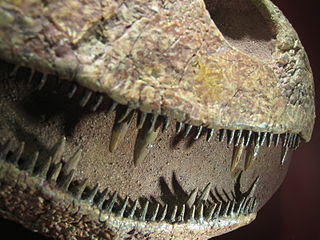
Tristichopterids (Tristichopteridae) were a diverse and successful group of tetrapodomorph fishes living throughout the Middle and Late Devonian. They first appeared in the Eifelian stage of the Middle Devonian. Within the group sizes ranged from a few tens of centimeters (Tristichopterus) to several meters.
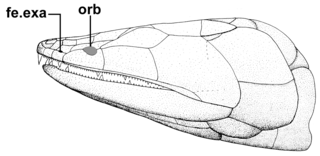
Mandageria fairfaxi is an extinct lobe-finned fish that lived during the Late Devonian period. It is related to the much larger Hyneria; although Mandageria was smaller, it probably hunted in the same way.

Onychodontiformes is an order of prehistoric sarcopterygian fish that lived during the Devonian period. The onychodontiforms are generally regarded as early-diverging members of the coelacanth lineage.

Onychodus is a genus of prehistoric lobe-finned fish which lived during the Devonian Period. It is one of the best known of the group of onychodontiform fishes. Scattered fossil teeth of Onychodus were first described from Ohio in 1857 by John Strong Newberry. Other species were found in Australia, England, Norway and Germany showing that it had a widespread range.

Eusthenodon is an extinct genus of tristichopterid tetrapodomorphs from the Late Devonian period, ranging between 383 and 359 million years ago. They are well known for being a cosmopolitan genus with remains being recovered from East Greenland, Australia, Central Russia, South Africa, Pennsylvania, and Belgium. Compared to the other closely related genera of the Tristichopteridae clade, Eusthenodon was one of the largest lobe-finned fishes and among the most derived tristichopterids alongside its close relatives Cabonnichthys and Mandageria.

Barameda is a genus of rhizodont lobe-finned fishes which lived during the Tournaisian stage near the start of the Carboniferous period in Australia; fossils of the genus have been reported from the Snowy Plains Formation. The largest member of this genus, Barameda decipiens, reached an estimated length of around 3–4 metres (9.8–13.1 ft), while smallest species, B. mitchelli is estimated to have had a length of about 35 centimetres (14 in).
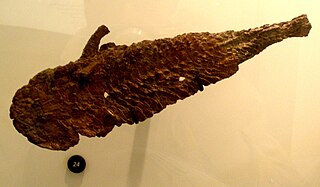
Megalichthyidae is an extinct family of tetrapodomorphs which lived from the Middle–Late Devonian to the Early Permian. They are known primarily from freshwater deposits, mostly in the Northern Hemisphere, but one genus (Cladarosymblema) is known from Australia, and the possible megalichthyid Mahalalepis is from Antarctica.
Eoactinistia is a prehistoric lobe-finned fish which lived during the Early Devonian period. Fossils have been found in Victoria, Australia.

Gorgonichthys is extinct monospecific genus of large arthrodire placoderm. Fossils are found in the Upper Famennian Cleveland Shales of Late Devonian in Ohio. The type species is Gorgonichthys clarki.
Mioceratodus is an extinct genus of lungfish in the family Neoceratodontidae, which also contains the extant Queensland lungfish. It is known only from Oligocene and Miocene-aged sediments in Australia, although phylogenetic evidence supports it having first diverged from its closest relative, Neoceratodus, during the Late Jurassic or Early Cretaceous period.
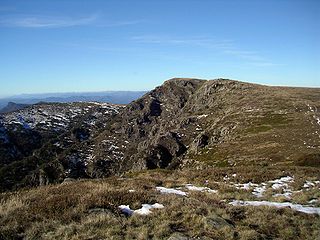
Marsdenichthys is an extinct genus of Devonian tetrapodomorph. Fossils have been found from Mount Howitt in Victoria, Australia from strata that are Givetian-Frasnian in age. Mount Howitt is an important site that has been the source of many tetrapodomorph fossils, including Beelarongia and Howittichthys, both of which were first described from the locality.
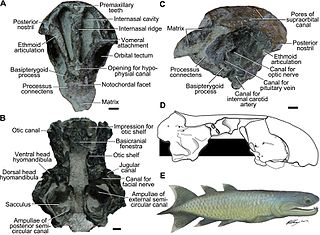
Qingmenodus is a genus of prehistoric lobe-finned fish. Fossils of Qingmenodus were found in China and date back to the Early Devonian period. Qingmenodus reveals the first well-ossified otoccipital braincase in onychodonts. Palaeontologists believe that Qingmenodus was one of the oldest onychodont fish.

Tinirau is an extinct genus of sarcopterygian fish from the Middle Devonian of Nevada. Although it spent its entire life in the ocean, Tinirau is a stem tetrapod close to the ancestry of land-living vertebrates in the crown group Tetrapoda. Relative to more well-known stem tetrapods, Tinirau is more closely related to Tetrapoda than is Eusthenopteron, but farther from Tetrapoda than is Panderichthys. The type and only species of Tinirau is T. clackae, named in 2012.
This list of fossil fishes described in 2017 is a list of new taxa of jawless vertebrates, placoderms, acanthodians, fossil cartilaginous fishes, bony fishes and other fishes of every kind that are scheduled to be described during the year 2017, as well as other significant discoveries and events related to paleontology of fishes that are scheduled to occur in the year 2017. The list only includes taxa at the level of genus or species.
Westralichthys is an extinct monospecific genus of dunkleosteoid from the Late Devonian: Middle Famennian stage from Western Australia. It is estimated to be 3 meters (9.8 ft) long.
The Mandagery Sandstone is a Late Devonian geological formation in New South Wales, Australia. It is one of several famed Australian lagerstätten, with thousands of exceptional fish fossils found at a site near the town of Canowindra.
References
- ↑ Johanson, Zerina; et al. (September 2007). "New Onychodontiform (Osteichthyes; Sarcopterygii) from the Lower Devonian of Victoria, Australia". Journal of Paleontology. 81 (5): 1031–1043. Bibcode:2007JPal...81.1031J. doi:10.1666/pleo05-023.1. S2CID 129852680.
- ↑ Lu, J., et al. 2016. A Devonian predatory fish provides insights into the early evolution of modern sarcopterygians. Science Advances, vol. 2, no. 6, e1600154, doi:10.1126/sciadv.1600154




